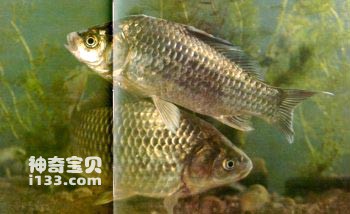Crucian carp (Carassius auratus auratus) belongs to the order Cypriniformes, family Cyprinidae, subfamily Cyprinidae, and genus Carassius. Commonly known as: Xitou, crucian carp Guaizi (Hubei), crucian carp melon seeds (Northeast), river crucian carp (Shanghai), Yue crucian carp (Guangdong); in ancient times they were called 鰿, crucian carp, and cold crucian carp. English name: Goldfish, crucian carp.
The body of crucian carp is flat and tall on the sides, with a body length of 2.2-2.8 times the body height, a round abdomen, a small head, a blunt snout, an end-positioned mouth with no whiskers, and flat hypopharyngeal teeth. ; Both the dorsal and anal fins have a thick spine with serrated rear edges. The scales are larger, the entire body is silver-gray, the back is dark gray, and the abdomen is gray-white.

Crucian carp is a widely distributed and widely adaptable fish, with strong adaptability to various ecological environments, from subtropical to tropical, regardless of the depth of the water body, running water or still water, clear water or turbid water, low oxygen, acid, alkali and other environments All can be adapted. It generally prefers to live in shallow rivers, lake branches, and ponds with overgrown aquatic plants and slow-moving water. It is not demanding about water temperature, food, water quality conditions, and spawning ground conditions. It can survive in conditions that other farmed fish cannot tolerate. Grow and reproduce in adverse environments. Crucian carp is also a wide-temperature fish and can ingest and digest food at water temperatures ranging from about 10°C to about 32°C. It can live for a long time in water with low oxygen content. It can only live for a long time in water with low oxygen content. It will only start to die when the oxygen content is as low as 0.1 mg/L. In a strong alkaline environment, It can also grow and reproduce in water (PH=9). Crucian carp is an omnivorous fish, and its diet is extremely broad and miscellaneous. Its animal food mainly consists of cladocerans, copepods, bryozoans, rotifers, freshwater shell vegetables, clams, chironomid larvae, shrimps, etc.; Plant foods are mainly plant detritus, and common ones include diatoms, filamentous algae, aquatic plants, etc. In southern my country, crucian carp can feed almost all year round; in the north, it stops feeding from December to March of the following year. June to August is their peak feeding period. Crucian carp grows slowly, only growing to 50 grams in one year, 100-150 grams in the second year, and more than 300 grams in the third year; the largest individual can reach 2.5 kilograms, and common individuals are generally around 250 grams. Crucian carp generally begins to mature at the age of 1 winter in the south, while in the north it generally reaches sexual maturity at the age of 2 winter. The spawning period can be extended from March to August. Most of the natural spawning grounds are in shallow lakes and bays covered with aquatic plants. The water temperature during spawning is above 15-16°C. Most of the time, after rain, the broodstock swim upstream to the spawning grounds to lay eggs. egg. The spawning grounds are chosen in shallow water areas with dense aquatic plants along lake bays and rivers. They can also lay eggs in still water environments such as ponds. Egg laying usually occurs in the middle of the night or early in the morning. The eggs are laid in batches, and the fertilized eggs are sticky and adhere to aquatic plants to develop. The sexual problem of crucian carp is quite complex. There have been reports of hermaphroditism, and some people also say that crucian carp has the ability to develop gynogenesis. In nature, there are more female fish than male fish, and the sex ratio of male to female fish is about 4:1.
Crucian carp is found in various waters in China except the Qinghai-Tibet Plateau.
Crucian carp has tender meat, delicious taste and high nutritional value. Each 100 grams of edible part contains 13.0-19.5 grams of protein, 1.1-7.0 grams of fat, 0.1-5.8 grams of carbohydrates, 0.9 grams of minerals (ash), 62-109 kcal of calories, 50-116 mg of calcium, and 192-192 phosphorus. 218 mg, iron 1.1-4.4 mg. Crucian carp is loved all over the country and is regarded as a top-quality food; especially for pregnant women, crucian carp soup can increase milk production. In natural water bodies, crucian carp production accounts for the highest proportion of total freshwater fish production. Because crucian carp has strong adaptability and can grow and reproduce in various water bodies, and the fish reaches sexual maturity at the first age, and the population recovers quickly, it has always been the target of breeding. There are many varieties of crucian carp cultured, and the common goldfish are variants of ordinary crucian carp that have been artificially screened and domesticated.
The whole crucian carp is sweet and warm in nature and flavor, and has the effects of opening the spleen and strengthening the stomach, increasing appetite, eliminating edema, stopping vomiting, and producing milk. Fish eggs can regulate and replenish Qi. The whole fish can be used as medicine to treat measles, mumps, toothache, gum swelling and pain, breast sores, the onset of breast cancer, lung pain, lung abscess, external hemorrhoids, spleen and stomach weakness, loss of appetite, edema, ascites, regurgitation, stomach pain, and postpartum women. Symptoms such as lack of milk and low postpartum milk. Its bile can cure carbuncles, nameless swelling and ecthyma.
animal tags:
We created this article in conjunction with AI technology, then made sure it was fact-checked and edited by a Animals Top editor.